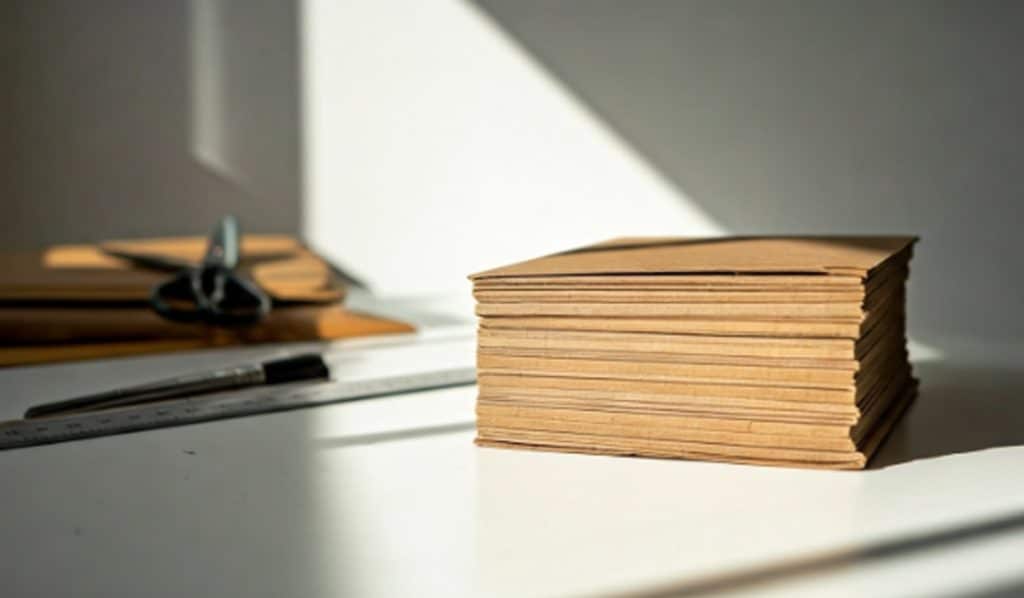DIY Guide: How to Make a Hardcover Book


Want to add a personal touch to your next creative project? This tutorial will help you make a hardcover book from the beginning.
You will find easy instructions and need basic materials like PVA (Polyvinyl Acetate) glue and book cloth. Following this guide, you can create a professional-looking book showing your unique style. Get ready to show your skills in bookbinding!
What preparations are required to create a hardcover book?
Start by gathering all the tools and materials you need. Make sure you have everything close by. You will need things like a book cloth, cardboard for the cover, PVA glue, a bone folder, and a cutting mat.
Creating a workspace is also very important. Pick a clean, flat surface where you can work without being disturbed. It's smart to protect this area from glue spills and make sure you have enough light for careful cutting and gluing. Now that your tools are ready and your workspace is set, let's start our bookbinding journey!
1. Tools and materials you will need
Alt text: A person working at a wooden table with various art supplies to take a measurement of a hardcover.
You need some essential tools and materials to make a nice and strong hardcover book. Get these things ready before you start how to make a hardcover book process:
For the cover:
- Book cloth or decorative paper: This will cover your hardcover.
- Greyboard (bookbinders cardboard): This strong cardboard is the base for your book's front, back, and spine.
- PVA glue: This glue works well for bookbinding because it sticks strongly.
- Cutting mat: This protects your work area when you use sharp knives.
For the text block:
- Text block: These are the printed pages of your book.
- Bone folder: A tool you can use to make clean folds and it also helps glue stick better when working with paper.
2. Setting up your workspace
Creating a tidy and functional workspace is very important for smooth bookbinding. First, choose a flat, clean surface with enough space for your tools and materials. A large table or desk works best. Make sure to remove any clutter and provide good lighting. This helps avoid eye strain when you work on detailed tasks.
Next, protect your workspace from glue and ink by placing a cutting mat or a piece of wax paper on the surface. This will make cleaning up easier later. Finally, keep some heavy objects, like books, nearby. You will use these to press down on the glued pieces. This ensures a strong bond while the glue is drying.
What are the steps to creating a hardcover book?
Now that you have set up your workspace and collected your materials, it's time to make your hardcover book. These simple steps will guide you in the process and help you create a durable and beautiful book.
Each step, from putting together your content to adding final touches, is essential for getting a professional look. Pay attention and enjoy the rewarding experience of making your own hardcover book.
Step 1: Gathering content for your book
Before you start with the book cloth or cardboard, think about what your hardcover book will be about. Are you making short stories, a photo album, or a personalised journal? Once you know, decide on the number of pages you need.
Keep in mind that a hardcover book is different from a paperback. The first page you see when you open a hardcover is the right side of the first sheet of paper. You can add a blank page at the start and end for an excellent finish. After completing your content, make sure it is formatted for printing.
Step 2: Measure & mark board placement
- Measure the height and width of the text block. This is the area of the bound pages in your book.
- Use these measurements to cut two pieces of greyboard for the front and back covers. Make sure they are a little bigger than the text block on all sides, allowing for a small overhang.
- Next, measure the width of the spine. This measurement tells you how thick your book will be.
- Cut a strip of greyboard to this exact width, and it should be the same height as your cover boards.
- A ruler marked with sixteenths of an inch can help you take accurate measurements. This way, you get a professional-looking book.
Step 3: Formatting your pages for printing
Once you have your content ready and take the measurement of the board, set up your pages to fit the size of your book. If you use a word processing program, change the page margins and size as needed. Don't forget to add any blank pages you want at the start or the end of your text block.
It’s smart to print a test copy. This helps you find any errors in the format. When you are happy with how it looks, save your document as a PDF. This format works with most printers. It also keeps your font, layout, and image quality the same in your printed text block.
Step 4: Printing your book pages
Now that your pages are ready, it's time to see your hard work in tangible form! Choose a printer that fits your project needs. A good-quality home printer will be enough if you need just a few copies. Consider using a professional printing service for more copies or a neater look.
Use strong, acid-free paper to ensure your book lasts a long time. If you're unsure which paper to pick, ask your local print shop for suggestions. The quality of your printing really affects the final product. Taking your time and being careful in these first steps will help you create a hardcover book you'll love.
Step 5: Assembling the book spine
With your text block ready, you can now make the spine board. This is the backbone of your hardcover book. First, figure out the thickness of the book’s spine. This is based on the number of pages and how thick the paper is in the text block. A thicker book will need a wider spine board.
Now, use a ruler and a bone folder to mark the cardboard along the lines you made before. This will create a hinge for attaching the cover boards. The scored line should be a bit wider than the thickness of the book spine. This makes it easier to turn the pages and helps the book spine stay flat and open smoothly.
Step 6: Creating and attaching the cover
To create the cover of the book, start by placing your chosen book cloth or decorative paper face down. Next, position the spine board and cover boards on the material. Make sure to leave some space between them for the spine. Take a pencil and lightly trace around the boards. This will give you a template for cutting.
Then, apply some PVA glue to the back of each board. Carefully align the boards on the book cloth, using the pencil marks to guide you. Use a bone folder to smooth out any air bubbles or wrinkles. Start from the centre and work your way out to keep it looking clean and professional. Finally, let the glue dry completely before you move on to the next step.
Step 7: Binding the pages to the cover
Now, it's time to attach the cover to the content by binding your printed pages. This step is very important for making your book look complete and professional. Start by putting a thin layer of glue on the spine of your text block. Make sure to cover it evenly. Don't use too much glue because it can leak into the pages and make them wrinkled.
Next, carefully line up the spine of your text block with the spine board of the cover. Press down firmly to make a strong connection. Use your bone folder to smooth out any air bubbles. This will help the pages stick well to the spine board. You need to be patient and steady during this part.
Step 8: Adding finishing touches
It's time to put the final special touches on your hardcover book. One great way to make it personal is by adding a dust jacket. A dust jacket protects your book and gives you space to show your creative side.
You can also add a ribbon bookmark. Pick a ribbon that matches your cover design and attach it to the spine of your book. Finally, consider using decorations, corner protectors, and other design elements to make your handmade book even more beautiful.
How ex why zed can help you make a professional-looking hardcover book?
Ex Why Zed can significantly assist you in creating a professional-looking hardcover book through a range of tailored services and resources. You can get a customised cover design, ensuring your book cover is visually appealing and resonates with your target audience.
For printing, Ex Why Zed delivers high-quality prints that capture vibrant colours and sharp text, along with various material options to suit your aesthetic preferences. Their expertise in hardcover binding includes customisation choices with additional options for foiling and embossing to enhance the book's overall appearance.
Their user-friendly online platform allows for easy file uploads, selection of options, and tracking of the production process. By leveraging these comprehensive services, you can streamline the creation of a hardcover book that looks professional and meets your specific needs.
Final thoughts
Making a hardcover book at home can be fun and satisfying. If you follow the step-by-step guide, you can create a nice-looking book just as you want. Handmade hardcovers are also a great gift or a personal treasure. If you want help to get a smooth finish, check out how Ex Why Zed can improve your hardcover book-making. Enjoy the art of bookbinding and show off your creativity with custom hardcovers that highlight your skills.
Frequently Asked Questions
What is the Best Paper Type for Hardcover Books?
The best paper for hardcover books is strong and thick. It is acid-free and lasts a long time. High-quality paper helps your book stay in good shape for many years. It will not turn yellow or become fragile.
How Long Does It Take to Make a Hardcover Book at Home?
The time required to make a DIY hardcover book can differ based on how complicated it is. Usually, it takes a few hours to a couple of days. This includes time for the glue to dry and for adding any extra decorations.
How does one turn paperback books into hardcover books?
Turning paperbacks into hardcovers needs special bookbinding methods. You first take off the old binding. Then, you make the spine stronger. Lastly, you attach new hardcover boards.
What is the best binding method for hardcover books?
The best way to bind hardcover books depends on how thick the book is and how strong you want it to be. Some popular binding methods are case binding, perfect binding, and saddle-stitching. Case binding usually gives the strongest and longest-lasting result.

